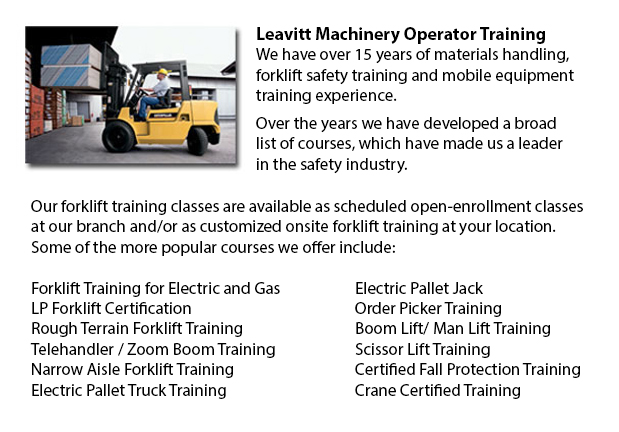
Ottawa Forklift Training School - Forklift Training School - For The Safety Of Both The Equipment And The Operator - Industry and federal regulators have established the criteria for forklift safety training according to their existing regulations and standards. People wishing to utilize a forklift must finish a forklift training program prior to working with one of these machines. The accredited Forklift Operator Training Program is meant to offer trainees with the practical skills and information to become an operator of a forklift.
Mobile Equipment and Vehicle safety regulations that apply to forklift use include pre-shift inspections, and regulations for loading and lifting.
An inspection checklist should be done and given to the supervising authority before beginning a shift. When a maintenance issue is uncovered, the utilization of the particular machinery must be discontinued until the issue has been addressed. To be able to indicate the machine is out of service, the keys must be removed from the ignition and a warning tag placed in a place which is visible.
Loading safety rules include checking the forklift nameplate's rating capacity and determining if the weight of the load falls within capacity. The forklift forks should be in the downward position when the forklift is starting up. Remember that there is a loss of roughly 100 pounds carrying capacity for every one inch further away from the carriage that the load is carried.
Lifting must begin with the driver moving to a stopped position around three inches away from the load. The mast should then be leveled until it has reached a right angle with the load. Raise the forks to an inch under the slot on the pallet and drive forward. After that lift forks four inches. Tilt back the load to be able to secure it for moving. Drive the lift backwards if the load obscures frontal vision. Check behind and honk to warn other staff. Do not allow forks to drag on the ground.
-
Ottawa Boom Lift Ticket
Ottawa Boom Lift Ticket - Boom Lifts are a table lift piece of equipment which could be lifted or lowered to varying heights, making this apparatus a useful tool for many manufacturing purposes. There are some unique types of Boom Lift consisting of... More -
Ottawa Boom Lift Operator Training
Ottawa Boom Lift Operator Training - The cherry picker work platform is a kind of work platform, which will typically have a bucket or platform at the hydraulic lifting system's end. The device is also referred to as a man lift, boom lift, basket cra... More -
Aerial Lift / Boom Lift / Man Lift / Scissor Lift Training in Ottawa
Scissor lifts are forklift tables which raise objects and people and supplies vertically. They are normally utilized in industrial, construction and commercial environments. A common use of scissor lifts is for lifting or lowering construction suppli... More -
Ottawa Crane Certification
Ottawa Crane Certification - The Crane Certification training program covers content suggested by industry concerning the safe and efficient operation of cranes. Individuals training would know the following: pre-operational, operational and post ope... More -
Ottawa Heavy Equipment Training Courses
Ottawa Heavy Equipment Training Courses - The first step required to take when selecting heavy equipment operator courses is determining the capacity you wish to work with heavy machinery. Like for example, you can take courses that will teach you ho... More -
Ottawa Fall Protection Ticket
Ottawa Fall Protection Ticket - Fall-related accidents are the number one reason of death in the construction trade. The potential for fall accidents very much increases based on the kind of work which is being completed within your workplace. So, be... More -
Ottawa Telehandler Operator Training
Ottawa Telehandler Operator Training - Telescopic handler Forklifts or telehandler forklifts are common industrial machinery seen in various construction business settings. The telehandler is a useful machine and makes for a valuable tool that can be... More -
Fall Protection Training in Ottawa
Regrettably, there is a large number of workplace injuries linked to falling and lots of fall-related deaths reported each year. Lots of these instances might have been prevented by having proper measures in place, offering proper training and equipp... More

Forklift Certification Ottawa
TOLL FREE: 1-888-254-6157
Ottawa, Ontario
forkliftcertificationottawa.com
Email Us
About Us


